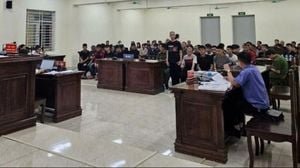Hanoi is embarking on a significant administrative reorganization that aims to rename and restructure its commune-level administrative units, with a focus on preserving the city's unique cultural heritage. The plan, which follows directives from the Politburo and the City Party Committee, is designed to streamline operations and enhance governance efficiency in the capital.
According to the draft proposal developed by the Hanoi Department of Home Affairs, the reorganization will prioritize maintaining distinctive names such as Hoan Kiem, Hai Ba Trung, and Dong Da. This approach reflects a commitment to ensuring that the rich cultural identities of various neighborhoods are preserved even as the administrative landscape changes.
During a meeting on April 3, 2025, Mr. Tran Dinh Canh, the Director of the Hanoi Department of Home Affairs, emphasized the importance of creating new commune and ward names that are easily recognizable, concise, and systematic. He noted, "New commune and ward names should be easily recognizable, concise, and systematic." This clarity is essential for effective governance and public engagement.
To facilitate the reorganization, Hanoi is encouraging the use of numerical designations for new communes and wards, such as Thanh Xuan 1, Thanh Xuan 2, and Dan Phuong 1, Dan Phuong 2. This method not only simplifies the naming process but also aids in the digitalization of administrative data, making it easier to manage and update information.
Moreover, the city is advocating for the retention of existing names from pre-reorganization administrative units, particularly those that hold historical, traditional, and cultural significance. Mr. Canh added, "The city encourages using existing names of pre-reorganization administrative units with historical, traditional, and cultural value supported by the local population." This approach aims to foster a sense of continuity and respect for local history.
For the historical inner-city administrative units, which embody revolutionary cultural traditions, the plan stipulates that the names of districts will be utilized for the newly formed wards. For instance, the name Hoan Kiem will be retained for one of the new wards, while additional wards will adopt different names to avoid duplication.
Hanoi's historical districts, including Hoan Kiem, Ba Dinh, Dong Da, and Hai Ba Trung, will play a crucial role in this reorganization. Each district will retain its identity, with Hoan Kiem preserving the cultural essence of its famous 36 ancient streets, while Ba Dinh will continue to serve as the national political-administrative center.
As part of the reorganization process, the city will seek feedback from various stakeholders, including leaders of departments, agencies, and districts. After gathering these opinions, the Hanoi City People's Committee will finalize the proposal and present it to the City Party Committee before submitting it to the City People's Council and the Government for approval.
According to projections from central authorities, the total number of commune-level administrative units in Hanoi is expected to decrease by approximately 50% following the reorganization. Currently, Hanoi boasts 526 commune-level administrative units, comprising 160 wards, 345 communes, and 21 towns. If the proposed changes are implemented, this number will be reduced to 263 units.
This significant reduction in administrative units is aimed at enhancing governance efficiency and ensuring that local administrative structures are better aligned with the needs of the population. By streamlining administrative processes, the city hopes to improve service delivery and foster stronger community engagement.
In conclusion, Hanoi's ambitious plan to reorganize its administrative units reflects a thoughtful approach to governance that respects the city's rich cultural heritage while adapting to modern administrative needs. As the city moves forward with this initiative, the emphasis on preserving local identities and engaging the community will be crucial in achieving a successful transition.





